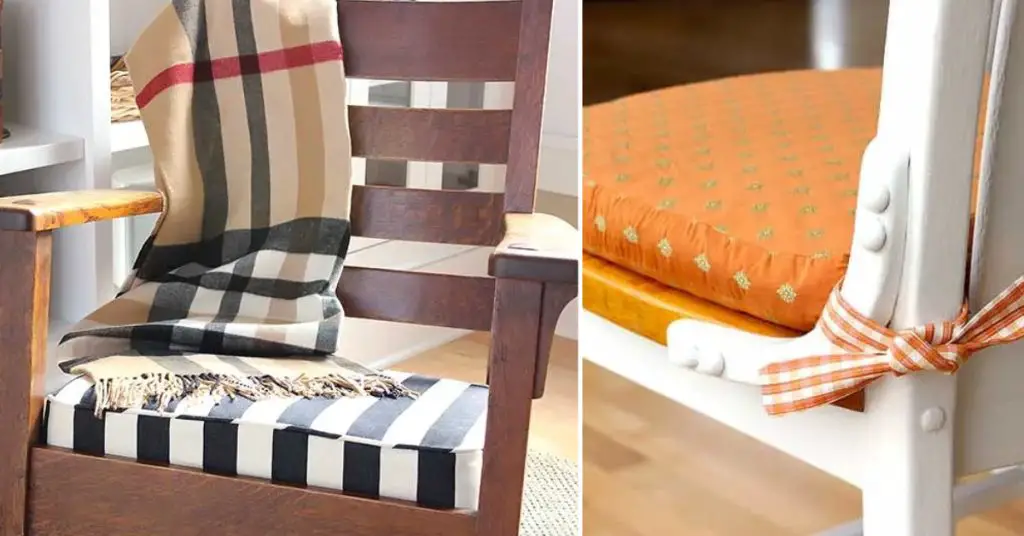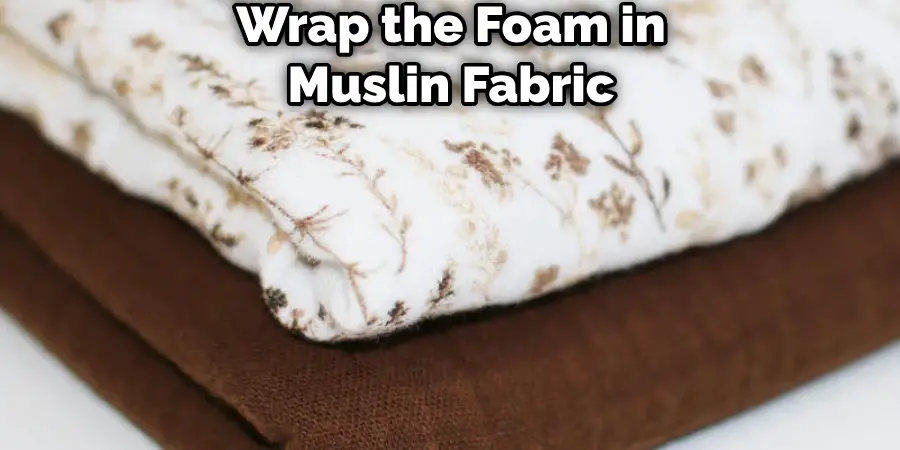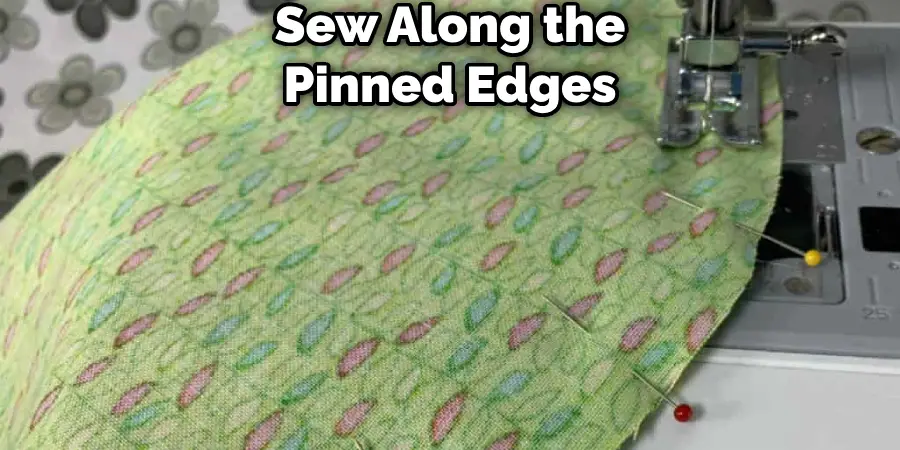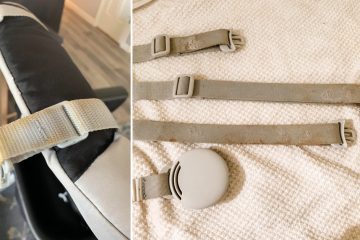Are you tired of sitting on uncomfortable chairs? Do you want to add a touch of color and comfort to your seating? Look no further! In this comprehensive guide, we will show you how to make a chair cushion with foam from scratch. Whether you’re a seasoned crafter or a DIY beginner, this project is perfect for adding comfort and style to any chair in your home. So, let’s get started!

9 Easy Steps for How to Make a Chair Cushion With Foam
Before we dive into how to make a chair cushion with foam, let’s gather all the materials you’ll need to make your chair cushions. Here’s a list of the essential items:
Materials Needed:
- Foam for chair cushions
- Piping for chair cushions
- Fabric for the cushion cover
- Scissors
- Sewing machine
- Measuring tape
- Pins
- Thread
- Iron
Step 1: Preparing the Foam Insert
The first step in making your chair cushion is to prepare the foam insert. Measure the dimensions of your chair seat and purchase a pre-cut foam cushion that matches those measurements. If necessary, add an extra inch to each dimension to account for the fabric pieces. To protect the foam and the inside of the fabric cover, wrap the foam in muslin fabric. Spray a little adhesive on the top and bottom of the foam, then wrap the muslin around it like an envelope.

Press the fabric in place and trim off any excess. Next, repeat the process with Dacron, an upholstery batting that adds a smooth and luxurious feel to the cushion. Wrap the Dacron around the foam-wrapped muslin and secure it in place. Set the foam insert aside to allow the adhesive to dry.
Step 2: Sewing the Side Assembly
To create the sides of your chair cushion, cut four fabric pieces: two measuring 3 inches by 18 inches and two measuring 3 inches by 16 inches. Take one of the shorter fabric pieces and one of the longer fabric pieces and sew them together along the shorter edge, with the right sides facing each other. Repeat this process with the remaining fabric pieces. Press the seams open to create a clean finish. You now have the side assembly for your cushion. Set it aside for now, as we will attach it later in the assembly process.
Step 3: Making Piping for the Cushions
Piping adds a professional and finished look to your chair cushions. While you can use store-bought piping, making your own gives you the freedom to choose the fabric and thickness that best suits your project. To make your piping, cut bias strips of fabric that are 2 inches wide. You will need approximately 4 yards of bias strips in total. If you’re short on fabric, you can create continuous bias strips using a bias tape maker.
Once you have your bias strips, join them together by sewing the ends with the right sides facing each other. Trim the seams to 1/4 inch and press them open. Fold the bias tape in half lengthwise and insert the cotton cording. Stitch along the edge of the bias tape, securing the cording in place. Measure and mark a chalk line 1/2 inch away from the stitching line to ensure even piping. Trim any excess fabric beyond the chalk line. Your homemade piping is now ready to be added to the cushion.
Step 4: Adding Piping to the Cushion Top and Bottom
Now it’s time to add the piping to the top and bottom of your chair cushion. Start by pulling out a small portion of the cording from one end of the piping. Cut off about an inch of the cording and tug on the piping to remove any bulk. Pin the piping to the cushion top, aligning the raw edges of the fabric with the raw edges of the piping. When you reach a corner, clip into the piping’s seam allowance to help it bend smoothly. Continue pinning the piping until you reach the starting point, leaving a few inches of excess piping.

Using a zipper foot, sew the piping to the cushion top, stitching close to the piping cord. Trim the excess piping, leaving a couple of inches overlapping the starting point. Repeat this process for the cushion bottom, but only attach piping to the short sides and one long side.
Step 5: Attaching Ties to the Chair Cushion
To ensure that your chair cushion stays in place, it’s a good idea to attach ties to the back corners. Cut two fabric strips measuring 2 inches by 18 inches for the ties. Fold the raw edges of each tie strip towards the center, then fold the strip in half lengthwise. Sew along the open edge to secure the folds in place. Attach one end of each tie to the back corners of the cushion, stitching them securely.
Step 6: Choosing the Right Fabric
When selecting fabric for your chair cushion, consider the style and durability you desire. Opt for a fabric that complements your decor and can withstand regular use. Upholstery or outdoor fabric are excellent choices due to their durability and resistance to stains. Keep in mind that patterned fabric may require additional planning to ensure the pattern aligns properly on the cushion. Consider whether you want the pattern to run horizontally, vertically, or diagonally on the cushion.
Step 7: Cutting and Sewing the Fabric Pieces
Fold your fabric in half with the right sides together. This allows you to cut the top and bottom pieces of the cushion cover simultaneously. Position the foam on top and trace its shape onto the fabric, leaving a 1cm margin for seam allowance. If your cushion is rectangular or square, you can fold the fabric in half with one side aligned with the fold and cut the shape accordingly. For circular or oval cushions, trace the foam shape directly onto the fabric.
Cut out the fabric pieces, ensuring you have a top and bottom piece along with the side strip. If you have separate pieces, sew the side strip to one of the fabric pieces, right sides together, following the shape of the cushion. If you have a fold in the fabric, start sewing the side strip to the back wall of the cushion cover.
Step 8: Assembling the Chair Cushion
With all the fabric pieces ready, it’s time to assemble the chair cushion. If you have separate fabric pieces, pin the side strip to the remaining fabric piece, right sides together, leaving an opening for inserting the foam. If you have a fold in the fabric, pin the side strip to one side of the back wall, leaving the front open. Sew along the pinned edges, making sure to reinforce the corners. Trim the seam allowance and clip the corners to allow for smoother and neater edges when turned right side out.

Turn the cushion cover right side out through the opening or by unfolding the fabric. Insert the foam into the cover, gently maneuvering it into place. If necessary, adjust the fabric to ensure a snug fit around the foam.
Step 9: Finishing Touches
To complete your chair cushion, hand-stitch the opening closed or sew it using a sewing machine. Make sure the stitches are secure and hidden from view. Give your cushion a final press with an iron to smooth out any wrinkles. Place the cushion on your chair, tie the attached ties around the chair back, and adjust as needed for a perfect fit.
FAQs About How to Make a Chair Cushion With Foam
What is the Most Comfortable Foam for Chairs?
The most comfortable foam for chairs is high-density polyurethane foam. It is recommended for cushioning and padding in furniture, offering a balance of comfort, support, and durability, making it suitable for dining chairs, couch cushions, and other heavily used areas. High-density foam is ideal for upholstery projects, providing ultimate comfort when layered properly. This type of foam is well-suited for various applications, including furniture cushioning, mattress toppers, and outdoor furniture due to its ability to maintain shape and provide long-lasting comfort.
What is the Best Cushioning Material?
The best cushioning material for various applications is high-density polyurethane foam. This type of foam offers an excellent balance of comfort, support, and durability, making it ideal for cushioning and padding in furniture. It is commonly used in chairs, couch cushions, outdoor furniture, and more due to its ability to provide long-lasting comfort and support. High-density polyurethane foam is known for its resilience and ability to maintain its shape over time, making it a top choice for cushioning material.
What Type of Foam is Best for Seat Cushions?
The best type of foam for seat cushions is high-density polyurethane foam. This foam offers a more consistent level of support and comfort than commercial-grade polyurethane foam, making it ideal for heavily used areas like chairs and couch cushions. It is also well-suited for upholstery projects and outdoor furniture due to its ability to maintain shape and provide long-lasting comfort. High-density foam is a medium-quality industrial-grade foam commonly used in mattresses, average-quality sofas, chair cushions, bay windows, and boats, offering excellent durability and resilience.
Conclusion
Congratulations! You have successfully created your chair cushion from start to finish. By following this step-by-step guide, you can revitalize how to make a chair cushion with foam with added comfort and style. Remember, making chair cushions is a versatile DIY project that allows you to personalize your seating and transform any chair into your favorite spot. Experiment with different fabrics, colors, and patterns to suit your taste and home decor. Now it’s time to sit back, relax, and enjoy the newfound comfort of your stylish chair cushions. Happy crafting!


